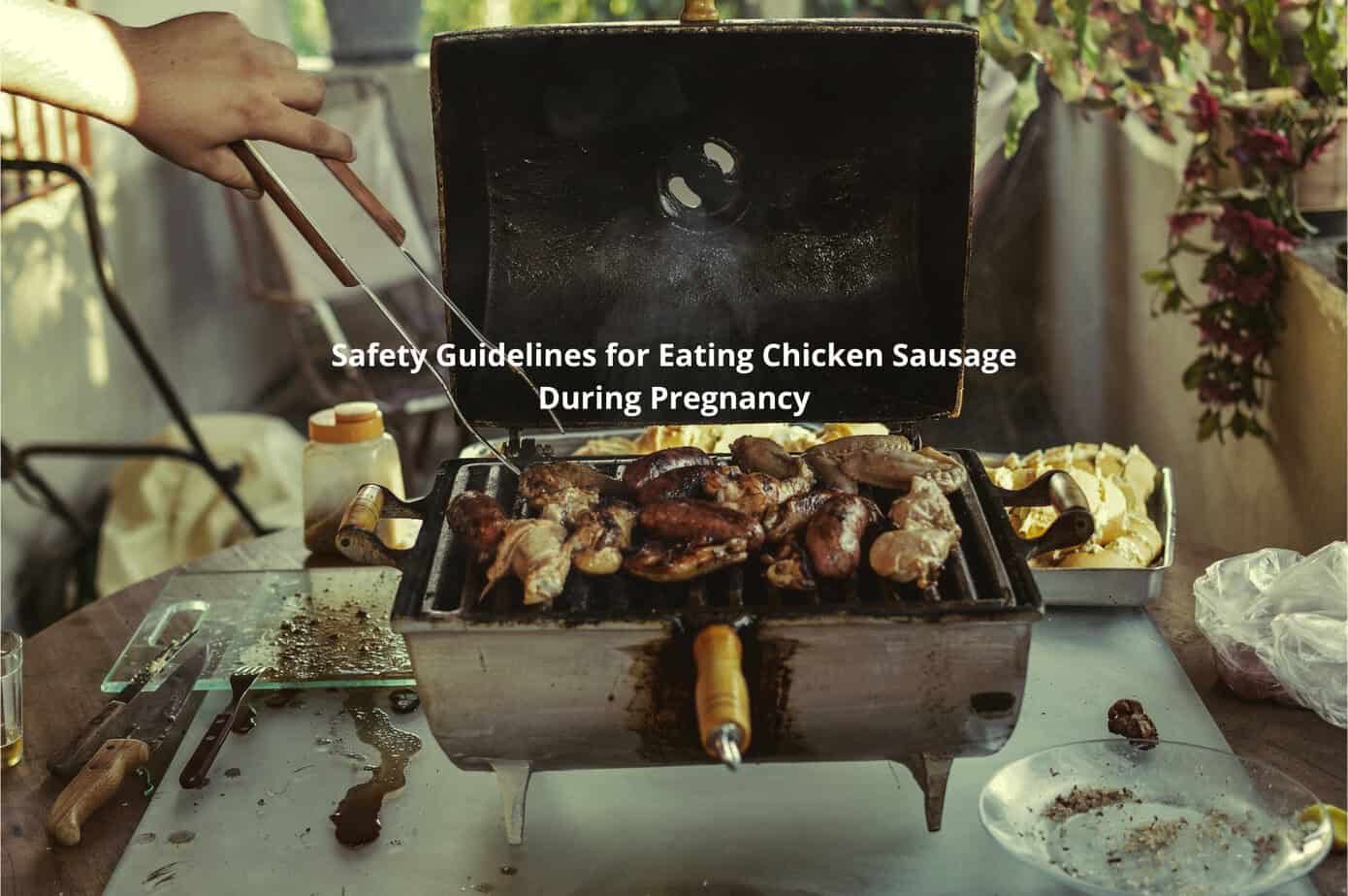Can you eat chicken sausage when pregnant? Yes, but only if it’s fully cooked to 165°F and eaten fresh.
Undercooked or poorly stored sausage can carry harmful bacteria like Listeria or Salmonella, which pose real risks during pregnancy.
The good news? You don’t have to skip it completely. Chicken sausage can be a safe, protein-rich choice when handled the right way.
Always read labels, store it properly, and use a thermometer. Craving sausage while expecting? You can enjoy it, just don’t guess about safety.
Keep reading for clear, fact-based rules on how to make it pregnancy-safe.
Key Takeaway
- Chicken sausage is safe in pregnancy if thoroughly cooked to 165°F and handled with care.
- Pay attention to sodium, additives, and always choose fresh, not cured, sausage.
- Watch for foodborne illness symptoms and talk to your doctor with any concerns.
Safety Guidelines for Eating Chicken Sausage During Pregnancy

Thorough Cooking Requirements
The rule for all poultry, including chicken sausage, is to cook it to an internal temperature of 165°F (73.8°C). This is the temperature at which harmful bacteria like Salmonella and Listeria are destroyed. Color alone is not a reliable indicator; sausage may appear done on the outside but remain undercooked inside. Use a food thermometer, inserted into the thickest part of the sausage, to check the temperature. The sausage should be steaming hot throughout.Skipping this step is not worth the risk. Salmonella and Listeria infections in pregnancy have been linked to severe outcomes, including hospitalization, miscarriage, and even stillbirth. A thermometer takes out the guesswork and is widely recommended by food safety authorities and obstetricians. If you have not used one before, they are inexpensive and easy to find in most supermarkets.
Risks of Undercooked or Raw Sausage
Eating undercooked or raw chicken sausage is one of the most preventable risks in a pregnancy diet. Undercooked sausages may harbor Listeria, Salmonella, or E. coli. These bacteria can cause foodborne illnesses that are much more severe in pregnant women. Complications can include high fever, dehydration, preterm labor, and infection of the unborn child. Even sausages that look cooked may not be safe unless you have verified their internal temperature.It is also important to note that, while rare, some sausages may be contaminated during processing and packaging. This makes proper cooking and reheating essential every time.
Choosing Sausage Types
Freshly cooked chicken sausage is the safest option. Cured, pre-packaged, or cold sausages (such as those found on deli trays or charcuterie boards) carry a higher risk of bacterial contamination. These products are often not cooked to a high enough temperature or may have been stored for extended periods. If you do choose a pre-cooked or cold sausage, it should always be reheated until steaming hot before eating.You may also notice a variety of specialty sausages at the market labeled “smoked,” “cured,” or “ready-to-eat.” Unless the label specifically indicates the product is fully cooked and safe for pregnant women, it’s best to avoid these. Stick with sausage that is cooked fresh, just before you eat it.
Proper Handling and Storage
Food safety does not end at cooking. Once chicken sausage is cooked, it should be refrigerated promptly, within two hours, or within one hour if the weather is hot. Keep your refrigerator at or below 40°F (4°C). If sausage has been left out at room temperature for more than two hours, it should be thrown away. This is true for leftovers as well as sausage that was just prepared. When storing leftovers, use clean containers and label them with the date. Eat leftovers within three to four days. When reheating, ensure the sausage is steaming hot throughout before eating. Do not rely on microwave “hot spots”, use a thermometer if possible. Cross-contamination is another quiet hazard. Always use separate cutting boards and knives for raw and cooked foods. Wash hands thoroughly with soap and water after handling raw sausage. Clean all utensils and surfaces before and after preparation. These steps significantly reduce the risk of spreading bacteria from raw meat to other foods.
Chicken Sausage in Pregnancy: Safe or Risky? Watch Before You Eat

Source: Women’s Health and Harmony
Nutritional Benefits and Considerations of Chicken Sausage in Pregnancy
Chicken sausage can be a source of key nutrients during pregnancy, but it must be chosen carefully to avoid unnecessary sodium, fat, and additives.
Key Nutrients Provided
Chicken sausage is rich in protein, providing about 13 grams per link (roughly 85 grams). Protein is essential for fetal growth, muscle development, and immune function. Chicken sausage also supplies iron (about 1.5 mg per link), which helps prevent anemia and supports the baby’s blood supply. Vitamin B12 and zinc are present as well, contributing to brain development and healthy nerves (1). These are not trivial benefits. Iron deficiency is common in pregnancy and can lead to fatigue, low birth weight, and developmental delays. Getting enough protein and B12 can help prevent these complications, especially in women who do not eat red meat.
Fat and Sodium Content Awareness
One downside to sausage, even chicken sausage, is its fat and sodium content. While chicken is leaner than pork or beef, many chicken sausages are made with added fat to improve texture and flavor. A single sausage link can contain anywhere from 5 to 15 grams of fat and 400 to 600 milligrams of sodium.High sodium intake is linked to fluid retention, swelling, and high blood pressure, issues already common in pregnancy. To minimize these risks:
- Read labels carefully for sodium content.
- Choose “low-sodium” or “reduced sodium” varieties if available.
- Limit portion size. Sausage should be a small part of your meal, not the main course.
Pair sausage with high-fiber foods like vegetables or whole grains to help with digestion and maintain a balanced meal.
Organic and Additive-Free Choices
If you are concerned about additives, look for chicken sausage labeled “nitrate-free,” “organic,” or “no added hormones/antibiotics.” These products avoid some of the preservatives and chemicals found in conventional sausages. It’s worth mentioning that “all natural” does not always mean nitrate-free, always check the label.Certified organic chicken sausage is increasingly common and is produced without synthetic pesticides, hormones, or antibiotics. Many pregnant women prefer this for peace of mind, and it is widely available in most supermarkets.
Moderation in Diet
Chicken sausage can fit into a balanced pregnancy diet, but it’s not an everyday food. Most experts suggest limiting processed meats to once or twice a week. Even lean sausage, if eaten daily, can contribute to excessive salt and fat intake. Moderation also helps avoid digestive discomfort, such as heartburn or bloating, which are common complaints during pregnancy.Serve chicken sausage with plenty of fiber-rich sides and drink water with your meal. This supports digestion and helps prevent constipation, another frequent pregnancy challenge.
Health Risks Linked to Chicken Sausage Consumption During Pregnancy
Most issues with sausage in pregnancy come down to foodborne illness and digestive discomfort. These can, in rare cases, become serious for both mother and child.
Potential Foodborne Illness Symptoms
Foodborne illness can present with a variety of symptoms, often including:
- Stomach cramps
- Vomiting
- Diarrhea
- Fever
These symptoms may appear hours or days after eating contaminated sausage. If you experience symptoms like fever or vomiting, contact your healthcare provider, these could be signs of a serious infection. Early intervention can prevent complications.
Sausage and Pregnancy Complications
Improperly handled or undercooked sausage is linked to serious pregnancy complications, including miscarriage, premature birth, and stillbirth. Listeria, in particular, is a concern because it can cross the placenta and infect the fetus. Outbreaks linked to deli meats and sausages have been documented by health authorities.These risks underscore the importance of proper food safety practices, not just for peace of mind but for real health protection.
Digestive and Allergy Concerns
Chicken sausage may cause digestive issues such as bloating, gas, or heartburn. Some pregnant women develop new sensitivities to foods they previously tolerated. Sausage often contains spices, preservatives, or fillers that can trigger allergic reactions or discomfort. Pay attention to how your body responds.If you notice swelling, difficulty breathing, or hives after eating sausage, seek medical attention. For less severe symptoms like mild heartburn or bloating, reducing portion size or choosing simpler, additive-free sausage can help.
Importance of Clean Preparation Practices
Cleanliness in preparation cannot be overstated. Always:
- Use separate utensils and boards for raw and cooked sausage.
- Wash hands thoroughly after handling raw meat.
- Cook in clean pans and wipe down counters and surfaces immediately after preparation.
- Store sausage at the correct temperature and label leftovers.
These steps, while basic, are effective at preventing cross-contamination and foodborne illness.
Practical Tips for Including Chicken Sausage Safely in a Pregnancy Diet
A few simple habits can make chicken sausage a safe and enjoyable part of your pregnancy diet.
Checking Labels and Expiration Dates
- Always check ingredient lists for unwanted additives or allergens.
- Look for clear labeling: nitrate-free, low-sodium, organic, or hormone-free.
- Inspect the product, avoid sausage that looks discolored, smells off, or has a puffy package.
- Check sell-by and use-by dates before purchase and consumption.
Cooking Methods and Temperature Monitoring
- Grilling, boiling, and baking are all suitable methods for chicken sausage.
- Do not rely on appearance alone; always use a thermometer.
- Cook sausage until it reaches an internal temperature of 165°F (73.8°C) (2).
- Serve sausage steaming hot, not just warm.
Storage and Reheating Guidelines
- Refrigerate chicken sausage within two hours of cooking (or one hour if the weather is hot).
- Store at or below 40°F (4°C).
- Eat leftovers within three to four days.
- When reheating, ensure sausage is steaming hot throughout before serving.
Consultation with Healthcare Providers
- If you have questions about your diet, past food allergies, or digestive issues, consult your doctor or midwife.
- Discuss any symptoms that occur after eating sausage, such as stomach upset, rash, or fever.
- Consult your provider for tailored advice, especially if you have gestational hypertension, digestive issues, or dietary restrictions.
Conclusion
Chicken sausage can stay on your plate during pregnancy, as long as it’s fully cooked, fresh, and eaten in moderation. Always use a thermometer, choose high-quality options, and store it properly. If the taste or texture feels off, or your body reacts badly, it’s safer to skip it. Foodborne illness isn’t worth the risk. Pregnancy already comes with enough to manage, your meals should feel safe, not stressful. Respect the rules, and you can still enjoy it.
FAQ
What are the risks of undercooked sausage in pregnancy and how do I avoid listeria and sausage pregnancy complications?
Undercooked sausage in pregnancy can carry listeria, salmonella, and other harmful bacteria. These can increase the risk of miscarriage or premature birth. To avoid this, always cook sausage to a safe sausage temperature pregnancy guideline, at least 165°F. Avoid cold sausage and reheat leftovers until steaming. Don’t eat sausage that’s been left out too long, and keep raw and cooked food separate to prevent cross-contamination.
Is chicken sausage safe during pregnancy if it’s nitrate-free and low sodium?
Yes, chicken sausage is safe during pregnancy when it’s fully cooked, nitrate-free, and made with low sodium sausage pregnancy options. Check the label to avoid preservatives, additives, and excess salt that may cause bloating or high blood pressure. Choosing organic chicken sausage pregnancy varieties is also a good way to limit exposure to unwanted chemicals. Still, enjoy it in moderation as part of a balanced diet.
Can pregnant women eat cooked sausage if it’s stored and reheated properly?
Yes, pregnant women can eat cooked sausage if it’s handled safely. Follow sausage refrigeration pregnancy rules: refrigerate within two hours and reheat leftovers until steaming hot. Reheating sausage when pregnant is important to kill any leftover bacteria. Store at or below 40°F and toss anything left out too long. Always check the expiration date and appearance before eating.
What’s the best sausage for pregnancy to avoid digestive issues or allergies?
The best sausage for pregnancy is one that’s nitrate-free, low in sodium, and made from lean meat like chicken. Sausage and digestive issues pregnancy concerns are common, some women experience bloating, gas, or heartburn. Sausage allergies in pregnancy can also develop unexpectedly due to spices or additives. Try small portions first, and consult your doctor if any symptoms show up.
How can I safely include sausage and charcuterie pregnancy cravings in my diet?
To safely enjoy sausage and charcuterie pregnancy cravings, only eat sausage that has been thoroughly cooked and served hot. Avoid cold cuts, unless they’ve been reheated to steaming. Stick with fresh, not cured sausage, and skip the sausage and pizza pregnancy toppings unless fully cooked. For peace of mind, always follow food safety for pregnant women and check every label.
References
- https://pmc.ncbi.nlm.nih.gov/articles/PMC6161013/
- https://www.nhs.uk/pregnancy/keeping-well/foods-to-avoid/
Related Articles
- https://milkwoodrestaurant.com/are-chicken-sausages-safe-during-pregnancy/
- https://milkwoodrestaurant.com/chicken-sausage-low-fat-a-tasty-option-for-healthy-eating/
- https://milkwoodrestaurant.com/chicken-sausage-ground/
Was this helpful?

I’m Mary R. Q. , a seasoned professional chef dedicated to elevating home cooking experiences. Through my expertise in the culinary arts, I provide practical cooking tips and insightful reviews of kitchen utensils on my blog, milkwoodrestaurant.com. As a passionate advocate for transforming everyday meals into extraordinary culinary adventures, I aim to empower home cooks with the knowledge and tools they need to create delicious and memorable dishes. I’m also an author of the book “1,001 Kitchen Tips & Tricks: Helpful Hints for Cooking, Baking, and Cleaning (1,001 Tips & Tricks)” which is sold on Amazon. Join me on a flavorful journey as we explore the art of cooking and the essential tools that make it a joy.








